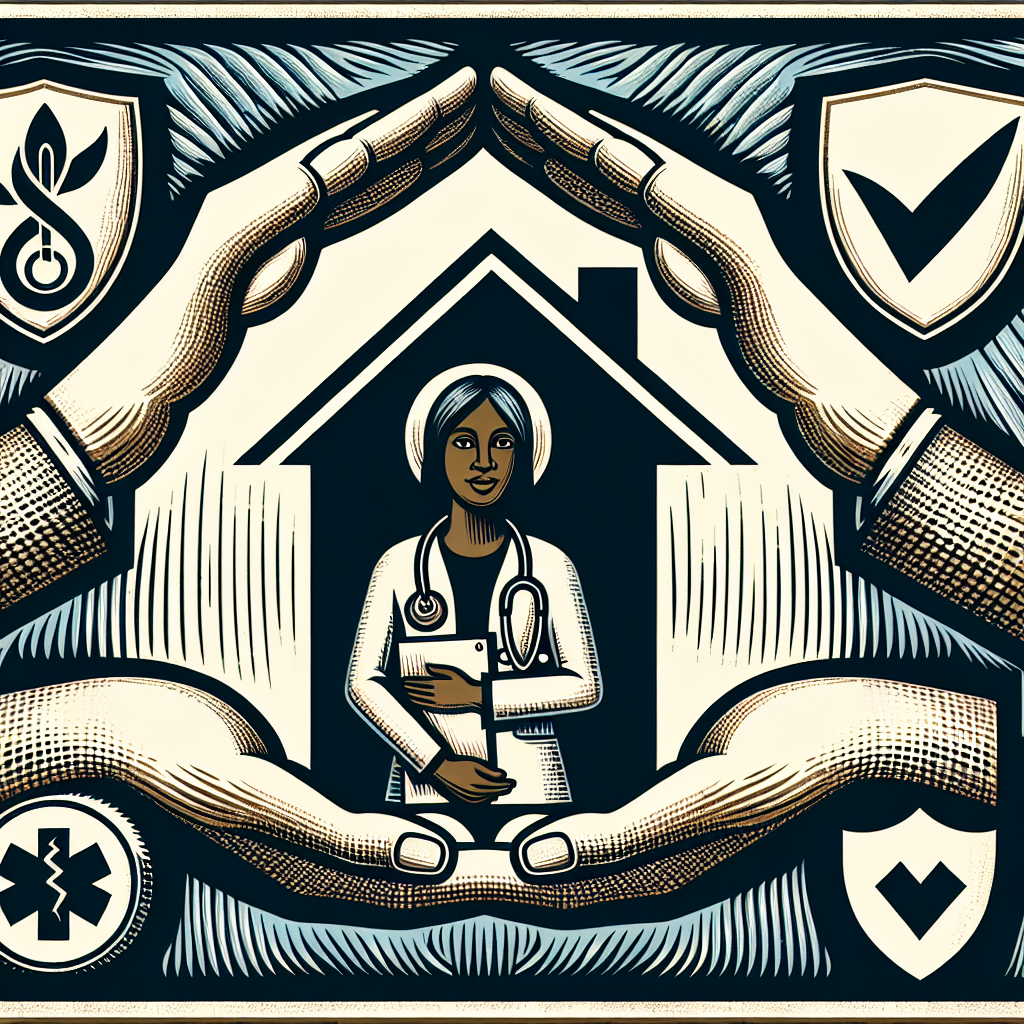Filed under Home Insurance on
In Home Health Care Insurance Coverage Explained

Understanding how to pay for care at home shouldn’t require a law degree. Families want straightforward answers about what’s covered, what isn’t, and how to avoid surprise bills. Consider this your practical guide—In Home Health Care Insurance Coverage Explained—with plain language, realistic examples, and current insights from Medicare, Medicaid, private insurance, and long-term care policies.
What counts as in-home health care?
Home-based care spans a spectrum. On one end is “home health,” which is medical and typically short-term—think skilled nursing visits, wound care, physical therapy after surgery, or speech therapy following a stroke. On the other end is “non-medical home care,” often called custodial or personal care—help with bathing, dressing, cooking, toileting, and companionship.
Insurers use these distinctions to determine whether and how much they pay:
- Home health: Ordered by a clinician, medically necessary, delivered by licensed professionals, and time-limited. Examples: skilled nursing visits, PT/OT/SLP, medical social work, and part-time home health aide services when tied to skilled care.
- Custodial/personal care: Non-medical assistance with activities of daily living (ADLs) such as bathing, dressing, and mobility. Typically ongoing and not covered by traditional health insurance unless through specific benefits (Medicaid HCBS, some Medicare Advantage plans, or long-term care insurance).
Clear definitions are the bedrock of benefits decisions and a big reason families search for In Home Health Care Insurance Coverage Explained before choosing providers or starting services.
At a glance: who pays for what?
- Medicare: Covers medically necessary, intermittent home health when criteria are met; does not cover 24/7 or ongoing custodial care.
- Medicaid: Often covers both medical and personal care at home through state programs and waivers for eligible individuals; rules vary by state and may include waitlists.
- Private/employer insurance: Typically covers short-term, post-acute home health; rarely covers long-term personal care.
- Medicare Advantage: Must cover at least what Original Medicare covers; some plans add supplemental in-home support services.
- Long-term care insurance: Designed to cover personal care and sometimes skilled care at home once benefit triggers are met.
- Veterans benefits: VA programs can fund in-home services, including homemaker/home health aide and “Aid & Attendance” pension supplements.
- Out-of-pocket: Fills the gaps when insurance doesn’t apply or caps are reached.
If you came searching for “In Home Health Care Insurance Coverage Explained,” here’s the quick answer: medical, short-term care is often covered; non-medical, long-term help usually isn’t—unless you qualify for Medicaid, have long-term care insurance, or your Medicare Advantage plan offers specific supplemental support.
Medicare coverage demystified
How Medicare Parts A and B interact
Medicare splits home health responsibilities between Part A and Part B. Generally, Part B finances most home health services. Part A may step in for patients coming from a hospital or skilled nursing facility if certain conditions are met. Regardless of part, coverage hinges on eligibility and medical necessity.
Eligibility checklist
- A physician or qualified practitioner orders home health services and reviews a plan of care.
- You need part-time or intermittent skilled services (nursing or therapy). “Intermittent” means fewer than seven days per week and usually under eight hours per day over a finite period.
- You are considered “homebound,” meaning leaving home requires considerable effort or assistance. You can still attend religious services, brief outings, or medical appointments.
- Care is provided by a Medicare-certified home health agency.
What Medicare covers
- Skilled nursing care (e.g., medication management, injections, wound care).
- Therapies: physical, occupational, and speech-language pathology.
- Medical social services.
- Home health aide services, but only when you’re also receiving skilled care; aides help with personal tasks like bathing.
- Durable medical equipment (DME), such as walkers or oxygen equipment, typically at 80% under Part B after the deductible.
What Medicare does not cover
- 24/7 in-home care or long-term custodial care when that is the only care you need.
- Homemaker services like housekeeping or meal delivery, unless incidental to covered care.
- Routine personal care if no skilled service is also being provided.
Costs and authorizations
- Medicare usually pays 100% of approved home health services; you pay 20% of DME costs under Part B.
- Medicare Advantage plans can require prior authorization and in-network agencies; check plan rules.
- There is no set day limit as long as you remain eligible, but services must be intermittent and reasonable based on your condition.
In Home Health Care Insurance Coverage Explained often starts with Medicare rules because they set the national baseline. Understanding the homebound requirement, the need for a skilled service, and the role of certified agencies is essential to unlocking benefits.
Medicaid and state home- and community-based services
Medicaid is the largest payer of long-term services and supports in the U.S. For those with limited income and assets, Medicaid can fund extensive in-home personal care in addition to medical home health.
HCBS waivers and state plan options
- 1915(c) waivers: Target specific populations (e.g., seniors, people with disabilities) and can cover personal care, homemaker services, respite, home modifications, and more.
- State plan personal care and 1915(i): Some states offer personal care without a waiver, expanding access but with service limits.
- Community First Choice (1915(k)): Enhanced federal match to expand personal attendant services; promotes self-directed care.
Eligibility varies by state
- Functional criteria: Often based on limitations in ADLs or need for institutional-level care.
- Financial criteria: Income and asset limits apply; spousal impoverishment protections can help a healthy spouse keep resources.
- Waitlists: Waivers may have caps; applying early helps.
Consumer direction and family caregivers
Many Medicaid programs let beneficiaries hire and manage caregivers, including some family members. Rules differ by state, particularly around paying spouses or legal guardians. Check your state’s specific program guidelines.
Private health insurance and employer plans
Commercial plans usually mirror Medicare’s medical focus. They cover post-acute home health when it’s short-term and tied to recovery, such as after a surgery or illness.
Common limits and authorization
- Visit caps, time limits, or medical review after a set number of visits.
- Prior authorization for skilled nursing or therapy at home.
- Network restrictions requiring a contracted home health agency.
- Exclusions for ongoing custodial care unless a rider applies.
Marketplace plans and essential health benefits
Individual and small-group plans must include essential health benefits, which typically encompass rehabilitative and habilitative services. That can include home health, but details vary by state benchmark plans and insurer policies. Always review your plan’s summary of benefits for home health criteria, copays, and limits.
Long-term care insurance (LTCI)
Long-term care insurance is purpose-built for non-medical supports, including aides and personal attendants at home. Benefits kick in once you meet the policy’s “benefit triggers.”
Benefit triggers to know
- Inability to perform two or more ADLs without substantial assistance, or
- Severe cognitive impairment requiring supervision (e.g., Alzheimer’s disease).
Most policies require a plan of care from a licensed professional and services from licensed or agency-affiliated caregivers.
Key policy features
- Elimination period: A waiting period (e.g., 30–90 days) before benefits pay, like a deductible measured in time.
- Benefit amount: Daily or monthly maximums (e.g., $150/day or $4,000/month) with a total pool of money or years of coverage.
- Inflation protection: 3% or 5% compound riders help benefits keep pace with costs.
- Care coordination: Some policies require or fund a care coordinator to optimize services.
- International benefits: Limited coverage outside the U.S. in some policies.
People looking for “In Home Health Care Insurance Coverage Explained” should know that LTCI, not traditional health insurance, is the main tool for funding ongoing in-home personal care.
Veterans benefits for care at home
- Homemaker/Home Health Aide: VA-funded personal care via contracted agencies, based on clinical need.
- Veteran-Directed Care: Provides a flexible budget for eligible veterans to hire and manage caregivers, often including family.
- Aid & Attendance: A pension add-on for wartime veterans and surviving spouses who need help with ADLs; funds can be used toward in-home care.
How to read a policy like a pro
Before starting services, decode the fine print. Look for these terms:
- Medical necessity and homebound criteria.
- Plan of care requirements and who must sign it.
- Provider qualifications (Medicare-certified, licensed agency, or independent caregiver rules).
- Network and prior authorization.
- Visit or hour limits; episode definitions (e.g., 60-day home health episode for Medicare plan-of-care reviews).
- Cost-sharing: deductibles, copays, coinsurance, and DME rules.
- Exclusions: custodial care, 24/7 care, unlicensed caregivers, transportation, or household tasks.
- Appeals process and timelines.
Step-by-step: filing and keeping a claim on track
- Confirm eligibility: Ask your clinician whether your needs rise to skilled care and whether you meet homebound criteria (for Medicare).
- Get the order: Ensure a written order and plan of care specify frequency, duration, and goals.
- Choose the right provider: Verify the agency is certified or in-network as required by your plan.
- Pre-authorization: Submit clinical notes and orders; document medical necessity thoroughly.
- Start services and document: Keep a care log, visit notes, and progress reports.
- Submit claims correctly: Follow plan instructions, include codes and documentation, and track submission dates.
- Manage denials: Review explanation of benefits, correct missing documentation, and file timely appeals with supporting letters from your clinician.
- Reassess regularly: Update the plan of care every 30–60 days or as your policy requires.
Think of this as your “In Home Health Care Insurance Coverage Explained” checklist for preventing delays and denials.
Common exclusions and pitfalls
- Custodial-only needs: If you require only help with bathing, dressing, and meals, Original Medicare will not cover ongoing services.
- 24/7 or live-in: Traditional health insurance doesn’t pay for round-the-clock attendants at home.
- Unlicensed or out-of-network caregivers: Can void coverage or reduce reimbursement.
- Home modifications: Ramps, bathroom remodels, and lifts are rarely covered, though Medicaid or some Medicare Advantage plans may offer limited support.
- Missed authorizations: Starting services before pre-approval can trigger denials.
- Documentation gaps: Vague notes or missing progress reports jeopardize continued coverage.
Costs to expect and how to budget
Prices vary by region, skill level, and hours. Recent industry surveys, such as the Genworth Cost of Care Survey, show median national monthly costs around:
- Homemaker services: roughly $5,300 per month (about 44 hours per week).
- Home health aide: roughly $5,600 per month for similar hours.
Hourly rates often range from the high $20s to mid $30s nationally, with major metros trending higher. Round-the-clock care can exceed $15,000–$25,000 per month. Durable medical equipment adds to costs, with Medicare Part B covering 80% of approved amounts after the deductible.
Budget tips:
- Price by level: Skilled nursing and therapy visits cost more than aide-level care.
- Consider hybrid schedules: Combine professional visits with trained family caregiving to extend your budget.
- Ask about care management: A nurse care manager can streamline services and reduce wasteful overlap.
- Check community programs: Local agencies on aging sometimes offer respite grants or volunteer support.
Tax and financial strategies
- Medical expense deduction: You may deduct qualified medical expenses above 7.5% of adjusted gross income; in-home nursing and some personal care prescribed by a clinician may qualify.
- HSA funds: Can pay qualified medical expenses, including a portion of long-term care insurance premiums within age-based IRS limits.
- Dependent Care FSA or credit: In some cases, non-medical care needed so you can work may qualify; rules are strict—consult a tax professional.
- State credits and programs: Some states offer caregiver tax credits or home modification grants.
- Medicaid planning: Elder law attorneys can advise on spend-down strategies and spousal protections while staying within legal guidelines.
Industry trends shaping coverage
- Shift to home: Health systems and payers are moving more services home to improve outcomes and reduce costs, including “hospital at home” pilots.
- Value-based purchasing: Medicare’s Home Health Value-Based Purchasing model ties payment to quality, encouraging better care coordination.
- Medicare Advantage expansion: Many MA plans now offer supplemental in-home support services, meal delivery, and caregiver support for chronically ill members.
- Remote care: Remote patient monitoring and virtual visits supplement in-person care, often improving adherence and extending coverage value.
As payers expand benefits, “In Home Health Care Insurance Coverage Explained” keeps evolving—especially through Medicare Advantage innovations and Medicaid’s home- and community-based services.
Expert tips to maximize your coverage
- Start with the right diagnosis and goals: Specific clinical goals (e.g., wound closure, gait training milestones) help justify skilled services.
- Document functional change: Show progress or the need to prevent decline; both can support continued therapy coverage.
- Use the care team: Physicians, therapists, and social workers can craft strong plans of care and assist with authorizations.
- Check benefits before discharge: If leaving a hospital or rehab, coordinate home health orders early to avoid gaps.
- Leverage appeals: Many initial denials are reversed with better documentation and physician letters.
- Blend benefits: Combine Medicare-covered skilled care with LTCI-funded personal care or Medicaid HCBS when eligible.
- Review MA plan extras annually: Benefits change; shop during open enrollment if you need stronger in-home support.
Real-world scenarios
- Post-surgery rehab: A Medicare beneficiary gets a physician order for home PT and intermittent skilled nursing. Medicare covers visits at 100%, with the beneficiary paying 20% for any needed DME.
- Advancing dementia: Daily personal care is needed, but no skilled services are required. Medicare does not cover ongoing aides; the family relies on LTCI and, eventually, Medicaid HCBS when eligible.
- Chronic heart failure: A Medicare Advantage plan authorizes home health nursing for medication management and remote monitoring; supplemental benefits provide short-term in-home support services to reduce readmissions.
Frequently asked questions
Does Medicare pay for 24/7 in-home care?
No. Medicare covers intermittent skilled services and limited aide support linked to those services—not continuous, round-the-clock care.
What’s the difference between home health and home care?
Home health is medical, ordered by a clinician, and time-limited. Home care is non-medical personal assistance with ADLs and is often long-term. Coverage rules differ widely between the two.
Can a family member be paid as a caregiver?
Possibly. Medicaid programs in many states allow consumer-directed care that pays certain family members. Long-term care insurance may also reimburse if the policy allows and the caregiver meets requirements. Medicare generally does not pay family members for caregiving.
How long will Medicare cover home health?
As long as you meet eligibility criteria—need for intermittent skilled care, homebound status, and a physician-reviewed plan of care. There’s no fixed day limit, but services must remain reasonable and necessary.
When should I buy long-term care insurance?
Premiums are lower and underwriting easier in your 50s to early 60s, before health issues arise. Policies can be structured with inflation protection and tailored benefit periods.
What if my claim is denied?
Request the reason in writing, gather stronger clinical documentation, ask your clinician for a detailed letter of medical necessity, and file an appeal within the required time frame. Many denials hinge on missing or vague documentation.
Putting it all together
Here’s In Home Health Care Insurance Coverage Explained in one takeaway: match the type of care you need to the payer that funds it. Short-term, medically necessary services at home are usually covered by Medicare and commercial insurance—if you meet criteria and use qualified providers. Long-term, non-medical personal care is where Medicaid, long-term care insurance, veterans programs, and private funds come into play.
To stretch your benefits and reduce stress, confirm eligibility, insist on clear care goals, keep meticulous documentation, and coordinate with providers before services begin. As programs evolve and supplemental benefits expand, revisit your plan options yearly—especially if you’re on Medicare Advantage or expect changing care needs.
If you’ve read this far, you truly have In Home Health Care Insurance Coverage Explained—and the confidence to navigate your options with clarity, control, and compassion.
For families making decisions today, remember: start with the clinical need, verify the payer’s rules, and build a care plan that blends medical and personal support wisely. When in doubt, ask your physician, a licensed home health agency, or a benefits navigator to review your specific situation so you can tap every available resource.





